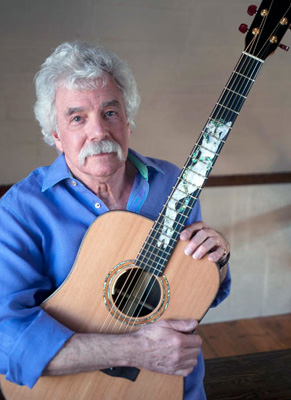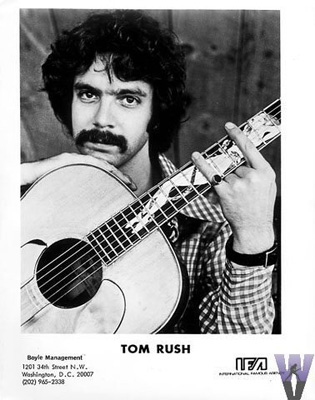"Tom Rush was not only one of my early heroes, but also one of my main influences." James Taylor
Folk Blues Icon Tom Rush to Appear at MIM
An Interview By Mariah Fleming
Tom Rush, one of the pre-eminent singer songwriters from the 1960’s folk and blues era, is appearing in concert at MIM in Phoenix on May 19th at 7PM.  His newest CD, "What I Know" is his first studio album in 35 years. It's getting rave reviews. That’s no surprise. Rush has had a profound impact on American music for decades. He helped shape and the folk revival in the 1960’s and has nurtured it along ever since. And he’s still making music, and selling out concerts.
His newest CD, "What I Know" is his first studio album in 35 years. It's getting rave reviews. That’s no surprise. Rush has had a profound impact on American music for decades. He helped shape and the folk revival in the 1960’s and has nurtured it along ever since. And he’s still making music, and selling out concerts.
Rush introduced the world to Joni Mitchell, James Taylor, Jackson Browne and many others. He continues to champion emerging artists, and helped bring the music of musicians like Nanci Griffith and Shawn Colvin to wider audiences when they were just starting their careers. And he’s got lots of stories to tell, including the one about his co billing with Alice Cooper. Yes, Alice Cooper. Some tickets to his show are still available. The intimate MIM music theatre is a perfect venue for his show. It’s acoustically remarkable, and so is Rush’s music. Tickets are $29.50 to $37.50.
Q. In 2009 you released your first full-length studio album in over thirty years, What I Know. It was voted "Album of the Year" by the International Folk Alliance. You recorded it in Nashville, featuring performances with Emmylou Harris, Nanci Griffith and Bonnie Bramlett. So much recording today is done in bits and pieces, often people just send in their tracks. Did you record "What I Know" together live in the studio? How did you like recording in Nashville?
A. The core band was live in the studio with me, but Emmy, Nanci and Bonnie overdubbed their contributions in that same studio while we all stood around in awe. Other parts, however, were recorded in White Plains, NY and Studio City, CA. The players I worked with in Nashville were absolutely fabulous. It was like getting a magic carpet ride!
Q.When I interviewed Shawn Colvin last August, we talked about the "Club 47 Music Series" that you created to champion newcomers. The original Club 47 was in Cambridge, Mass. where you got your first start. Can you tell us a bit about what performing at Club 47 was like in those days? And tell us about your work continuing the tradition of Club 47?
A. The Club 47 was tiny – 80 seats – and it was the one coffeehouse in the Boston area that made a point of finding and bringing in the legends (you could sit at the feet, literally, of the Carter Family!) It was a marvelous opportunity for the youngsters to learn directly from the Masters and, sometimes I suspect, vice versa. The Club 47 package shows I sometimes do today are a similar combination of established artists and newcomers.
Q. Who are some of your favorite singer songwriters today?
A. Good songs are where you find them. A.J. Swearingen comes to mind as someone who has not, I think, gotten the recognition he deserves.
Q. You made a big impact on the 'folk scene' in 1960's Boston and New York and you introduced the world to the songs of artists like Joni Mitchell, James Taylor and Jackson Browne. James Taylor told Rolling Stone magazine: "Tom Rush was not only one of my early heroes, but also one of my main influences." How did you become aware of their songs and when did you first meet them?
A. Each was a different story. I met Joni while playing a club in Detroit – she came in and did a guest set; James was introduced to me by Paul Rothschild, my producer – he was on his way to England and came by the Elektra offices in New York and we sat on the floor of an empty office while he played some songs for me; Jackson was published by Elektra, and I only knew him at that point through his demos.
Q. When you listen to music, typically what do you choose to listen to?
A. In the car I typically listen to whatever my 13 year-old daughter has on!
Q.Watching some videos of your recent concerts, you have a great gift not only for songwriting, but also for storytelling. You have a very engaging stage presence. What do you have in store for us at your MIM concert?
A. I won’t really know until the evening starts to unfold, but I’ll do some of the old stuff, some new things and, inevitably, tell some stories that are 100% true (or even better than true – having been polished, not unlike gemstones, in the tumbler of time.)
Q. On December 28, 2012 at Boston Symphony Hall you celebrated your 50th year performing. At the concert, you performed with artists like Jonathan Edwards, David Bromberg and Dom Flemons from the old time string band, the Carolina Chocolate Drops. What are your favorite memories from that concert?
A. The whole evening was fabulous, hanging and making music with some of my favorite people and players – there was a six-camera shoot going on and the DVD will be available soon.

Q. For your 2012 Boston Symphony Hall show you chose to go an unconventional route, bypassing the middleman by going to your fans and utilizing Kickstarter to fund your project. Kickstarter is such a groundbreaking idea. Do you think it's more or less challenging for songwriters to break into the music business today than it was in the 1960's and 1970's?
A. It’s way easier to break in because of the Internet – but it’s way harder to become a superstar via the conventional route because that route is going downhill rapidly.
Q. You started performing in 1961 while a student at Harvard University. What was your first paid gig? Your first album was recorded live at the Unicorn coffeehouse and released on the club's own label in 1962. It's long been out of print. But fortunately, in 2012 that 1962 classic was released on CD. What's it like to have your very first album available again after all these years?
A. The first gig was a $10 night at a coffee house called the Salamander. (I was fired after that first night because the owner was upset that the patrons were actually listening to me, rather than conversing, and drinking coffee, as they should have been.) It’s good to have the Unicorn album back in print - though it’s only available at my shows or TomRush.com.
Q. You were in the 1970 doc "Festival Express" that was filmed on a trans Canada private train with musicians like Buddy Guy, the Band, the Grateful Dead and many other famous performers from that era. What is the weirdest, funniest or most memorable thing you remember from that week?
A. My memories are a bit foggy, as anyone would understand if they watch the Festival Express documentary. It is available at TomRush.com, too.
Q. You're from Concord, New Hampshire and your dad was a schoolteacher. You wound up going to boarding school. Boarding schools have a reputation of being more like living in lock up. As a kid, coming from an environment that was the antithesis of the 1960's slogan "Question Authority" how did you emerge from that mindset to become one of the preeminent singer songwriters of a generation?
A. I had perhaps more Authority to question than kids that had led a more “normal” life.
Q. I first heard your music often, in the late 1960's, on a Phoenix free form radio station called KCAC. The station offered a place for new artists to be heard, and often had new artists as on air guests. Do you think the demise of live radio stations has created a different or more impersonal relationship to music for the satellite radio/iTunes generation?
A. That’s probably true. It’s been said that YouTube is currently the nation’s jukebox, and in that context you can find pretty much anything your ears (or eyes) could desire. (I have a clip there that’s had over 6 million plays now, so I’m a fan of YouTube!)
Q. You probably know that Alice Cooper is from Phoenix. You were on the same bill as Alice Cooper at a concert once. The idea of combining your music on the same bill as an act like Alice Cooper is unusual to say the least! What are your memories of that show? Were you the only acoustic act?
A. I have to say it was one of the oddest co-bills I’ve been on. My main memory of the evening, however, was that the same quirky (I’m being charitable here) promoter thought it would be a good idea to have a skydiver descend into the field during my set. The crowd was totally distracted by the spectacle and many started shining their flashlights up at the poor fellow. Blinded by all this candlepower he over-steered and landed straddling a chain-link fence.
Q. The first Tom Rush album I bought was "Circle Game" and I still cherish it. Is it true that Linda Eastman took that cover photo?
A. Yes.
Q. About ten years ago your wife Renee Askins wrote a compelling book about her work to save wolves. She made it her goal to restore wolves to Yellowstone National Park, who were eradicated by man over seventy years before. She founded The Wolf Fund. Do you work with her on this project? Is she still doing this work, and are wolves returning to Yellowstone?
A. The book, a lovely one, is called “Shadow Mountain: A Memoir of Wolves, a Woman and the Wild.” I did help out as much as I could with the project, which was successful. Wolves were reintroduced to Idaho, Montana and Wyoming in 1995, at which point Renée, having fulfilled her mission, shut down the Wolf Fund as she had promised to do. The wolves are flourishing biologically, though the state legislatures, especially in Wyoming, have been doing their redneck best to re-eradicate them. In WY there are minimal protections in a small band around Yellowstone, and no protection at all for 99% of the state. You can shoot ‘em, trap ‘em, poison ‘em 24/7 and in fact, are encouraged to do so. Don’t get me started!
Contact the author of this article at Editor@MusicAndMoreAZ.com.